Inhibition of Pro-Fibrotic Molecules Expression in Idiopathic Pulmonary Fibrosis—Derived Lung Fibroblasts by Lactose-Modified Hyaluronic Acid Compounds
Abstract
:1. Introduction
2. Materials and Methods
2.1. Chemicals and Compounds
2.2. Primary Human Pulmonary Fibroblasts and U937 Monocytes
2.3. Cell Viability Assay in the Presence of Hylach and HA Molecules
2.4. TGF-β Stimulation of Primary Human Pulmonary Fibroblasts
2.5. Activated U937 Monocytes Conditioned Medium
2.6. RNA Isolation and qPCR Analysis
2.7. Enzyme-Linked Immunosorbent Assay (ELISA)
2.8. Statistical Analysis
3. Results
3.1. TGF-β Stimulation of Lung Fibroblasts Upregulates the Expression of α-SMA and ECM Molecules
3.2. HA and Hylach at Different Percentages of Lactosylation Do Not Affect the Viability of Lung Fibroblasts
3.3. Hylach 1 and Hylach 2 Inhibits the Over-Expression of α-SMA and ECM Molecules in TGF-β Stimulated Lung Fibroblast Cultures
3.4. Hylach 1 and Hylach 2 Exert an Anti-Inflammatory Effect in Primary Human Lung Fibroblasts Cultures Exposed to CM of Activated Human Macrophages
3.5. The Effects of Hylach Compounds Are Correlated to the Downregulation of SMAD 2 Expression
4. Discussion
Author Contributions
Funding
Institutional Review Board Statement
Data Availability Statement
Conflicts of Interest
References
- King, T.E., Jr.; Pardo, A.; Selman, M. Idiopathic pulmonary fibrosis. Lancet 2011, 378, 1949–1961. [Google Scholar] [CrossRef] [PubMed]
- Glassberg, M.K. Overview of idiopathic pulmonary fibrosis, evidence-based guidelines, and recent developments in the treatment landscape. Am. J. Manag. Care 2019, 25, S195–S203. [Google Scholar] [PubMed]
- Hilberg, O.; Hoffmann-Vold, A.M.; Smith, V.; Bouros, D.; Kilpeläinen, M.; Guiot, J.; Morais, A.; Clemente, S.; Daniil, Z.; Papakosta, D.; et al. Epidemiology of interstitial lung diseases and their progressive-fibrosing behaviour in six European countries. ERJ Open Res. 2022, 8, 00597–02021. [Google Scholar] [CrossRef] [PubMed]
- Wynn, T.A. Integrating mechanisms of pulmonary fibrosis. J. Exp. Med. 2011, 208, 1339–1350. [Google Scholar] [CrossRef] [PubMed]
- Phan, S.H. The myofibroblast in pulmonary fibrosis. Chest 2002, 122, 286S–289S. [Google Scholar] [CrossRef] [PubMed]
- Herrera, J.; Henke, C.A.; Bitterman, P.B. Extracellular matrix as a driver of progressive fibrosis. J. Clin. Investig. 2018, 128, 45–53. [Google Scholar] [CrossRef] [PubMed]
- Fine, A.; Goldstein, R.H. The effect of transforming growth factor-beta on cell proliferation and collagen formation by lung fibroblasts. J. Biol. Chem. 1987, 262, 3897–3902. [Google Scholar] [CrossRef]
- Tatler, A.L.; Jenkins, G. TGF-β activation and lung fibrosis. Proc. Am. Thorac. Soc. 2012, 9, 130–136. [Google Scholar] [CrossRef]
- Zou, L.; Hong, D.; Li, K.; Jiang, B. Salt-inducible kinase 2 (SIK2) inhibitor ARN-3236 attenuates bleomycin-induced pulmonary fibrosis in mice. BMC Pulm. Med. 2022, 22, 140. [Google Scholar] [CrossRef]
- Argüeso, P.; Panjwani, N. Focus on molecules: Galectin-3. Exp. Eye Res. 2011, 92, 2–3. [Google Scholar] [CrossRef]
- McLeod, K.; Walker, J.T.; Hamilton, D.W. Galectin-3 regulation of wound healing and fibrotic processes: Insights for chronic skin wound therapeutics. J. Cell Commun. Signal. 2018, 12, 281–287. [Google Scholar] [CrossRef] [PubMed]
- Henderson, N.C.; Mackinnon, A.C.; Farnworth, S.L.; Poirier, F.; Russo, F.P.; Iredale, J.P.; Haslett, C.; Simpson, K.J.; Sethi, T. Galectin-3 regulates myofibroblast activation and hepatic fibrosis. Proc. Natl. Acad. Sci. USA 2006, 103, 5060–5065. [Google Scholar] [CrossRef] [PubMed]
- Ou, S.M.; Tsai, M.T.; Chen, H.Y.; Li, F.A.; Lee, K.H.; Tseng, W.C.; Chang, F.P.; Lin, Y.P.; Yang, R.B.; Tarng, D.C. Urinary Galectin-3 as a Novel Biomarker for the Prediction of Renal Fibrosis and Kidney Disease Progression. Biomedicines 2022, 10, 585. [Google Scholar] [CrossRef] [PubMed]
- Nishi, Y.; Sano, H.; Kawashima, T.; Okada, T.; Kuroda, T.; Kikkawa, K.; Kawashima, S.; Tanabe, M.; Goto, T.; Matsuzawa, Y.; et al. Role of galectin-3 in human pulmonary fibrosis. Allergol. Int. 2007, 56, 57–65. [Google Scholar] [CrossRef] [PubMed]
- Ho, J.E.; Gao, W.; Levy, D.; Santhanakrishnan, R.; Araki, T.; Rosas, I.O.; Hatabu, H.; Latourelle, J.C.; Nishino, M.; Dupuis, J.; et al. Galectin-3 Is Associated with Restrictive Lung Disease and Interstitial Lung Abnormalities. Am. J. Respir. Crit. Care Med. 2016, 194, 77–83. [Google Scholar] [CrossRef] [PubMed]
- Mackinnon, A.C.; Gibbons, M.A.; Farnworth, S.L.; Leffler, H.; Nilsson, U.J.; Delaine, T.; Simpson, A.J.; Forbes, S.J.; Hirani, N.; Gauldie, J.; et al. Regulation of transforming growth factor-β1-driven lung fibrosis by galectin-3. Am. J. Respir. Crit. Care Med. 2012, 185, 537–546. [Google Scholar] [CrossRef] [PubMed]
- Bouffette, S.; Botez, I.; De Ceuninck, F. Targeting Galectin-3 in Inflammatory and Fibrotic Diseases. Trends Pharmacol. Sci. 2023, 44, 519–531. [Google Scholar] [CrossRef]
- Donato, A.; Fontana, F.; Venerando, R.; Di Stefano, A.; Brun, P. The Anti-Inflammatory Effect of Lactose-Modified Hyaluronic Acid Molecules on Primary Bronchial Fibroblasts of Smokers. Polymers 2023, 15, 1616. [Google Scholar] [CrossRef]
- Denizot, F.; Lang, R. Rapid colorimetric assay for cell growth and survival. Modifications to the tetrazolium dye procedure giving improved sensitivity and reliability. J. Immunol. Methods 1986, 89, 271–277. [Google Scholar] [CrossRef]
- Tarricone, E.; Mattiuzzo, E.; Belluzzi, E.; Elia, R.; Benetti, A.; Venerando, R.; Vindigni, V.; Ruggieri, P.; Brun, P. Anti-Inflammatory Performance of Lactose-Modified Chitosan and Hyaluronic Acid Mixtures in an In Vitro Macrophage-Mediated Inflammation Osteoarthritis Model. Cells 2020, 9, 1328. [Google Scholar] [CrossRef]
- Donato, A.; Belluzzi, E.; Mattiuzzo, E.; Venerando, R.; Cadamuro, M.; Ruggieri, P.; Vindigni, V.; Brun, P. Anti-Inflammatory and Pro-Regenerative Effects of Hyaluronan-Chitlac Mixture in Human Dermal Fibroblasts: A Skin Ageing Perspective. Polymers 2022, 14, 1817. [Google Scholar] [CrossRef] [PubMed]
- Abatangelo, G.; Vindigni, V.; Avruscio, G.; Pandis, L.; Brun, P. Hyaluronic Acid: Redefining Its Role. Cells 2020, 9, 1743. [Google Scholar] [CrossRef] [PubMed]
- Sato, S.; Nieminen, J. Seeing strangers or announcing “danger”: Galectin-3 in two models of innate immunity. Glycoconj. J. 2002, 19, 583–591. [Google Scholar] [CrossRef] [PubMed]
- Tian, J.; Yang, G.; Chen, H.Y.; Hsu, D.K.; Tomilov, A.; Olson, K.A.; Dehnad, A.; Fish, S.R.; Cortopassi, G.; Zhao, B.; et al. Galectin-3 regulates inflammasome activation in cholestatic liver injury. FASEB J. 2016, 30, 4202–4213. [Google Scholar] [CrossRef] [PubMed]
- Pineda, M.A.; Cuervo, H.; Fresno, M.; Soto, M.; Bonay, P. Lack of galectin-3 prevents cardiac fibrosis and effective immune responses in a murine model of Trypanosoma cruzi infection. J. Infect. Dis. 2015, 212, 1160–1171. [Google Scholar] [CrossRef] [PubMed]
- Bartram, U.; Speer, C.P. The Role of Transforming Growth Factor β in Lung Development and Disease. Chest 2004, 125, 754–765. [Google Scholar] [CrossRef] [PubMed]
- Kadam, A.H.; Schnitzer, J.E. Characterization of Acute Lung Injury in the Bleomycin Rat Model. Physiol. Rep. 2023, 11, e15618. [Google Scholar] [CrossRef]
- Hetzel, M.; Bachem, M.; Anders, D.; Trischler, G.; Faehling, M. Different effects of growth factors on proliferation and matrix production of normal and fibrotic human lung fibroblasts. Lung 2005, 183, 225–237. [Google Scholar] [CrossRef]
- Singh, D.; Rai, V.; Agrawal, D.K. Regulation of Collagen I and Collagen III in Tissue Injury and Regeneration. Cardiol. Cardiovasc. Med. 2023, 7, 5–16. [Google Scholar] [CrossRef]
- Hughes, R.C. Galectins as modulators of cell adhesion. Biochimie 2001, 83, 667–676. [Google Scholar] [CrossRef]
- Idiopathic Pulmonary Fibrosis Clinical Research Network; Raghu, G.; Anstrom, K.J.; King, T.E., Jr.; Lasky, J.A.; Martinez, F.J. Prednisone, azathioprine, and N-acetylcysteine for pulmonary fibrosis. N. Engl. J. Med. 2012, 366, 1968–1977. [Google Scholar] [CrossRef] [PubMed]
- King, T.E., Jr.; Albera, C.; Bradford, W.Z.; Costabel, U.; Hormel, P.; Lancaster, L.; Noble, P.W.; Sahn, S.A.; Szwarcberg, J.; Thomeer, M.; et al. Effect of interferon gamma-1b on survival in patients with idiopathic pulmonary fibrosis (INSPIRE): A multicentre, randomised, placebo-controlled trial. Lancet 2009, 374, 222–228. [Google Scholar] [CrossRef] [PubMed]
- Borthwick, L.A.; Wynn, T.A.; Fisher, A.J. Cytokine Mediated Tissue Fibrosis. Biochimica et Biophysica Acta (BBA). Mol. Basis Dis. 2013, 1832, 1049–1060. [Google Scholar] [CrossRef]
- Wynn, T.A.; Chawla, A.; Pollard, J.W. Macrophage biology in development, homeostasis and disease. Nature 2013, 496, 445–455. [Google Scholar] [CrossRef] [PubMed]
- Heukels, P.; Moor, C.C.; Von Der Thüsen, J.H.; Wijsenbeek, M.S.; Kool, M. Inflammation and Immunity in IPF Pathogenesis and Treatment. Respir. Med. 2019, 147, 79–91. [Google Scholar] [CrossRef] [PubMed]
- Hadjicharalambous, M.R.; Roux, B.T.; Csomor, E.; Feghali-Bostwick, C.A.; Murray, L.A.; Clarke, D.L.; Lindsay, M.A. Long intergenic non-coding RNAs regulate human lung fibroblast function: Implications for idiopathic pulmonary fibrosis. Sci. Rep. 2019, 9, 6020. [Google Scholar] [CrossRef]
- Flanders, K.C. Smad3 as a Mediator of the Fibrotic Response. Int. J. Exp. Path. 2004, 85, 47–64. [Google Scholar] [CrossRef]
- Di Stefano, A.; Rosani, U.; Levra, S.; Gnemmi, I.; Brun, P.; Maniscalco, M.; D’Anna, S.E.; Carriero, V.; Bertolini, F.; Ricciardolo, F.L.M. Bone Morphogenic Proteins and Their Antagonists in the Lower Airways of Stable COPD Patients. Biology 2023, 12, 1304. [Google Scholar] [CrossRef]
- Di Stefano, A.; Sangiorgi, C.; Gnemmi, I.; Casolari, P.; Brun, P.; Ricciardolo, F.L.M.; Contoli, M.; Papi, A.; Maniscalco, P.; Ruggeri, P.; et al. TGF-β Signaling Pathways in Different Compartments of the Lower Airways of Patients with Stable COPD. Chest 2018, 153, 851–862. [Google Scholar] [CrossRef]
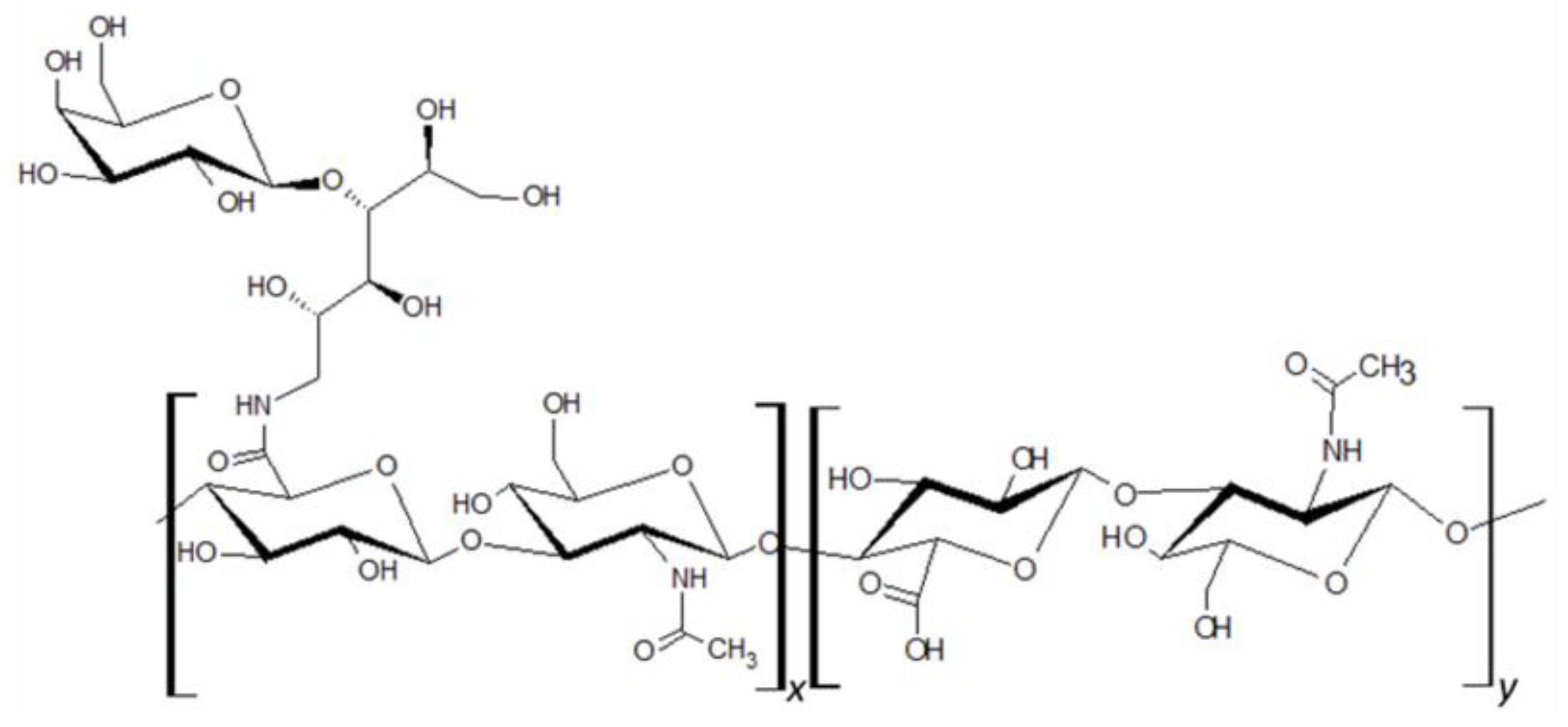

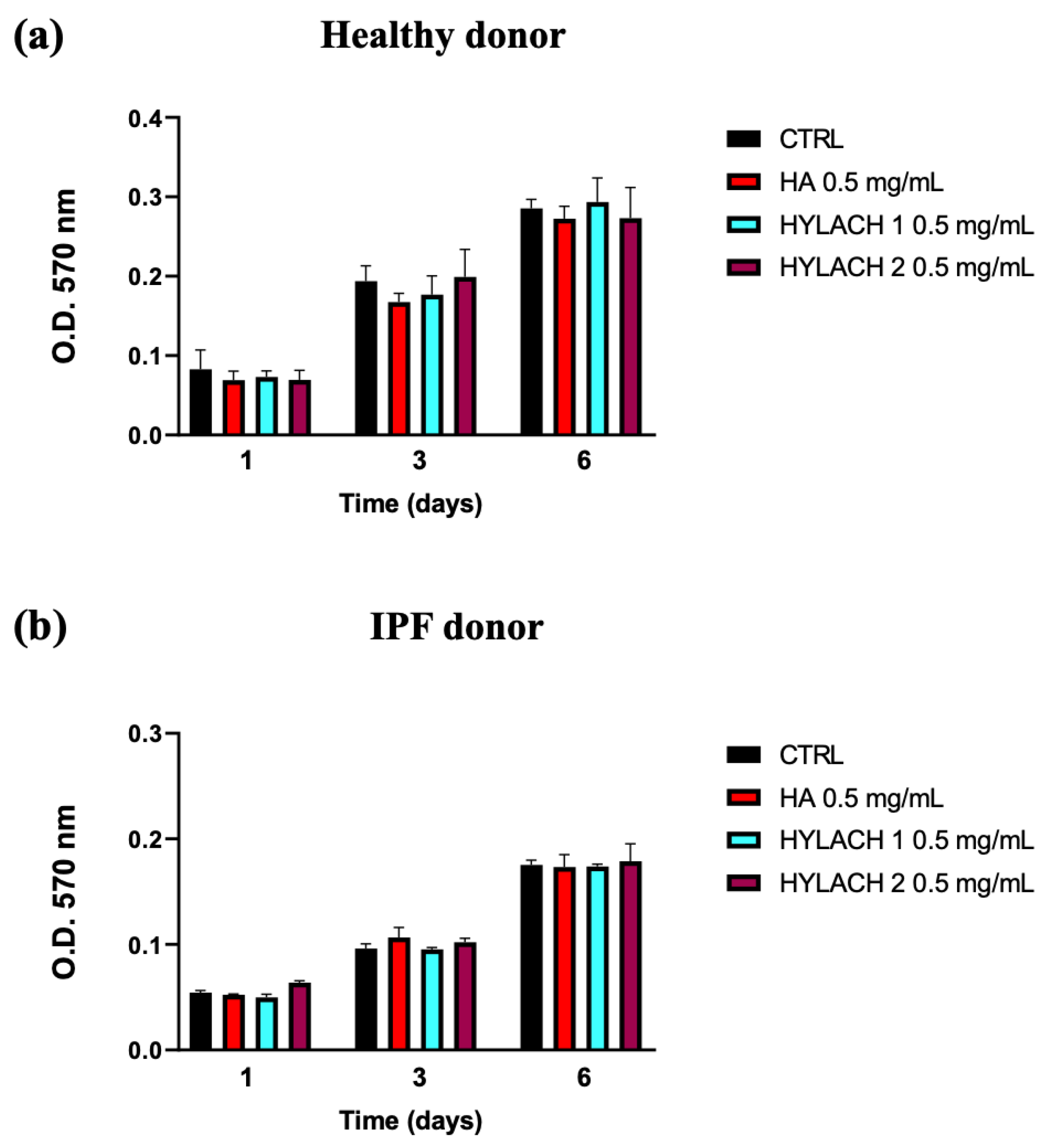
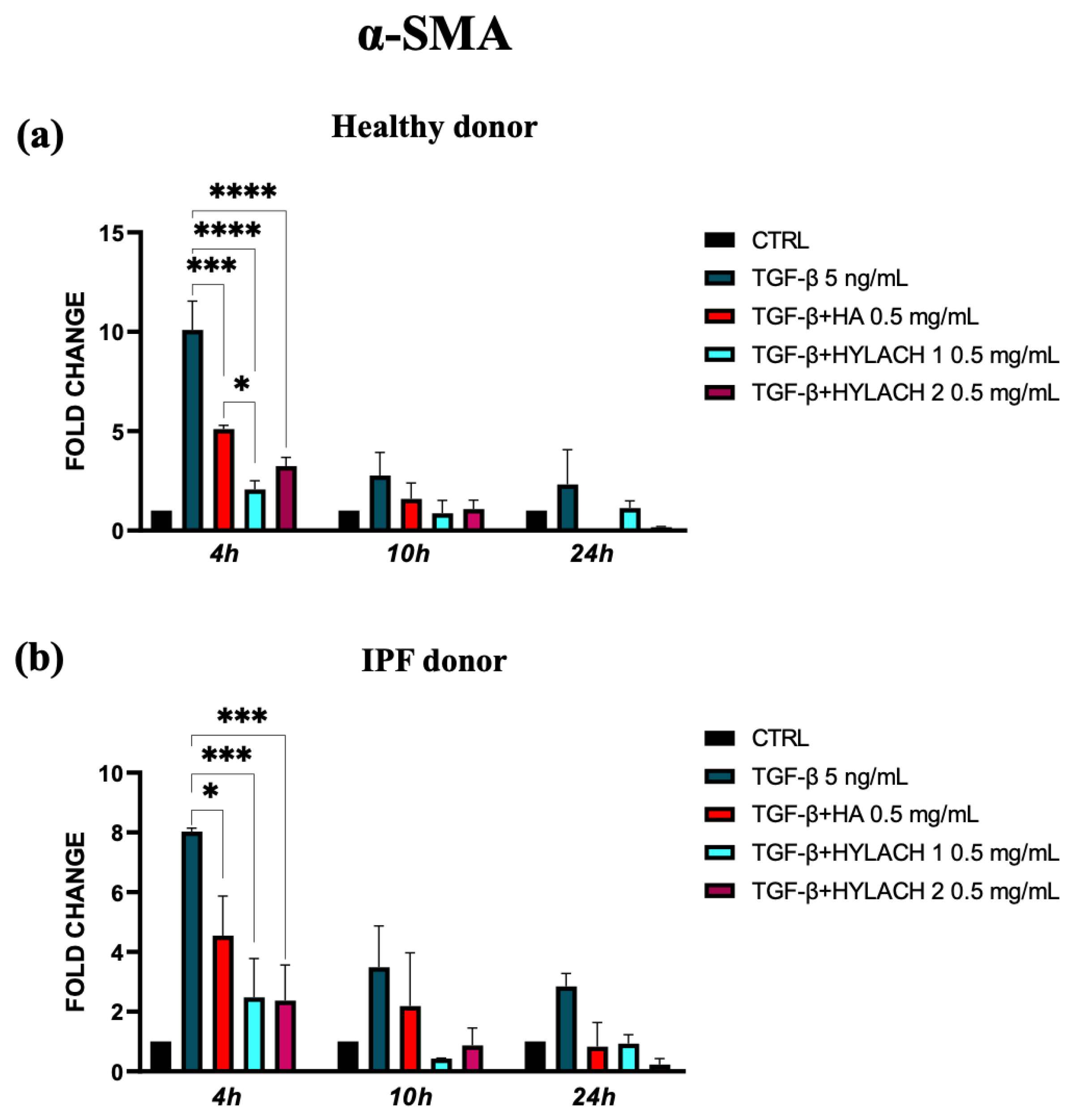
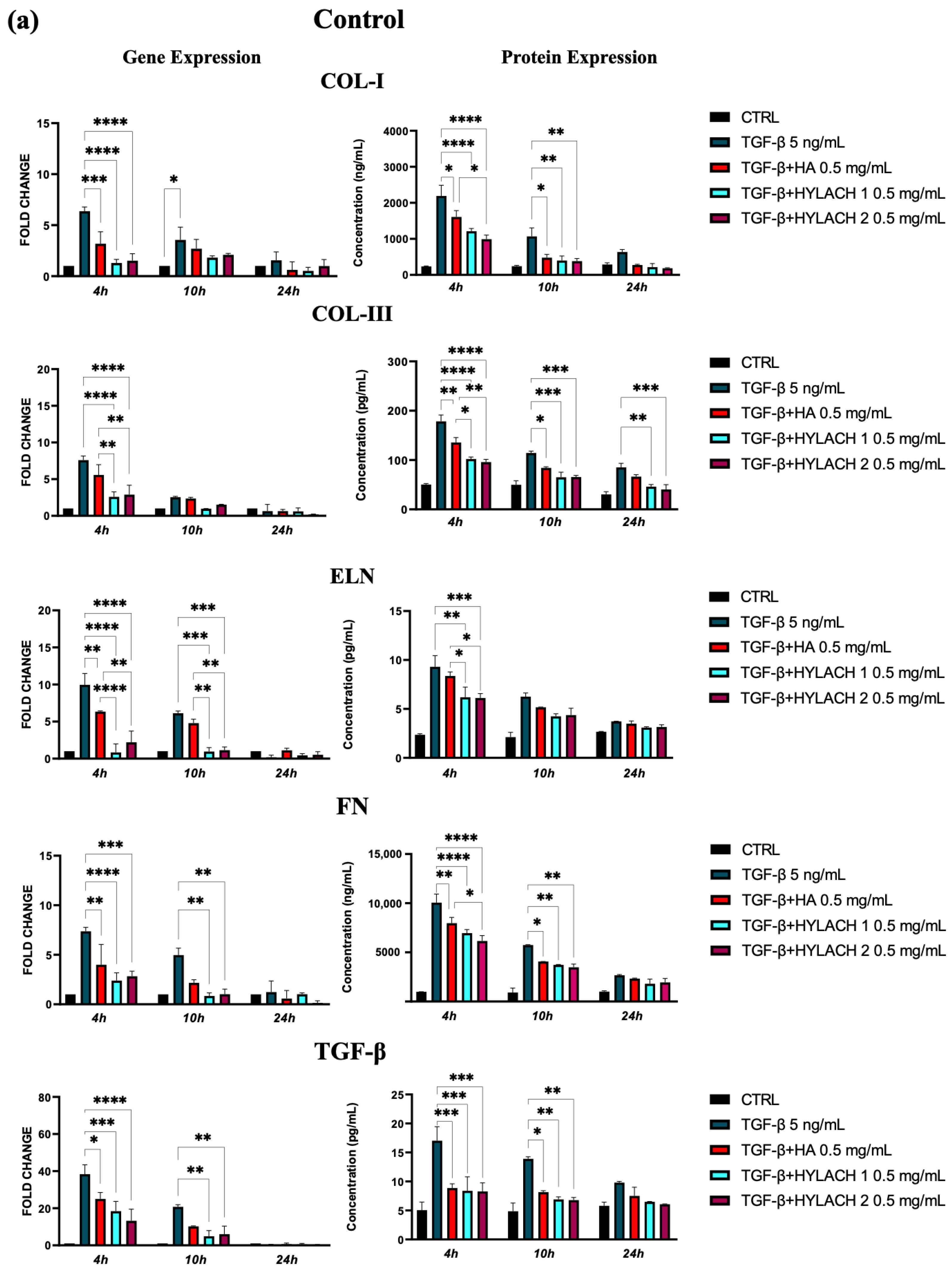

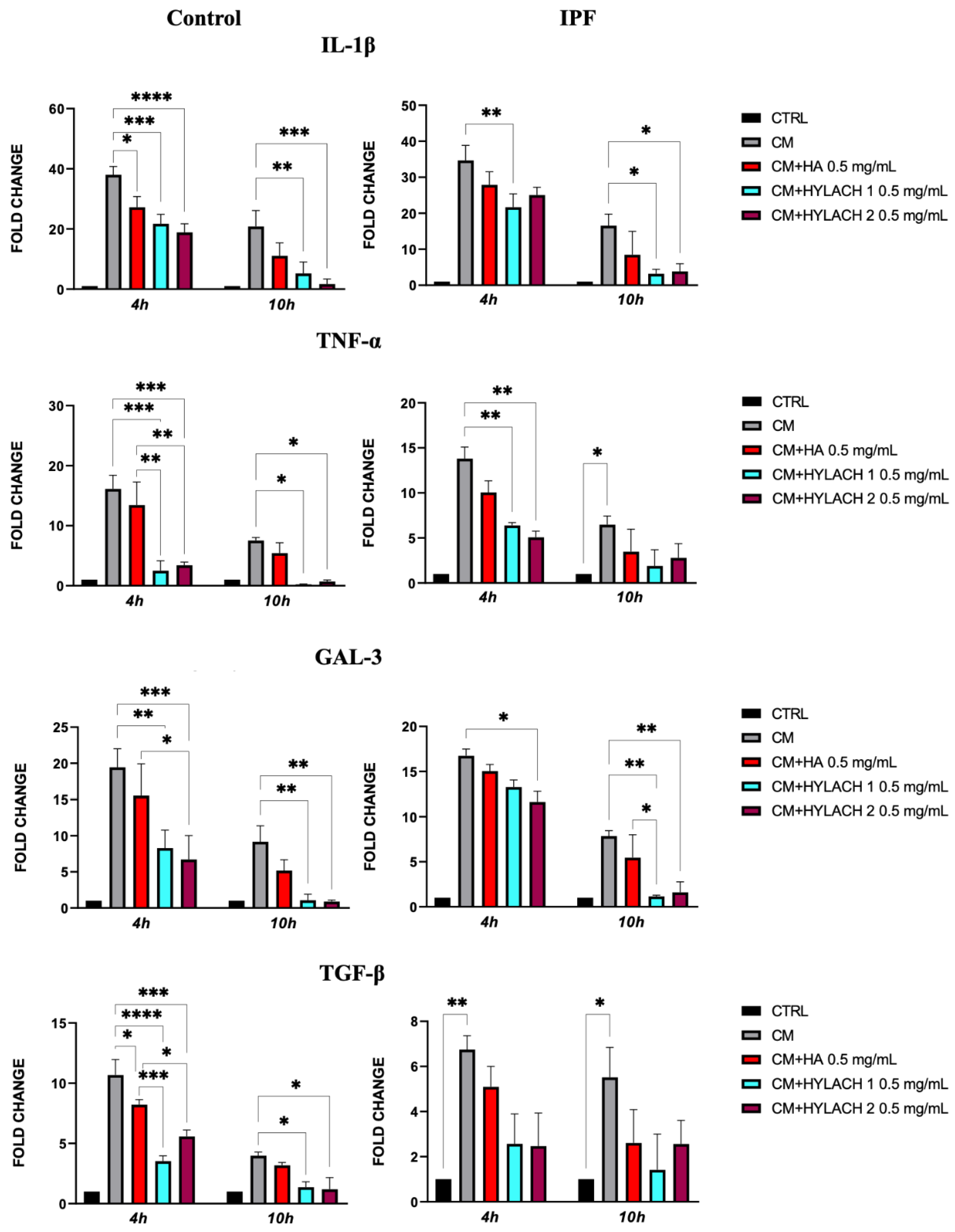
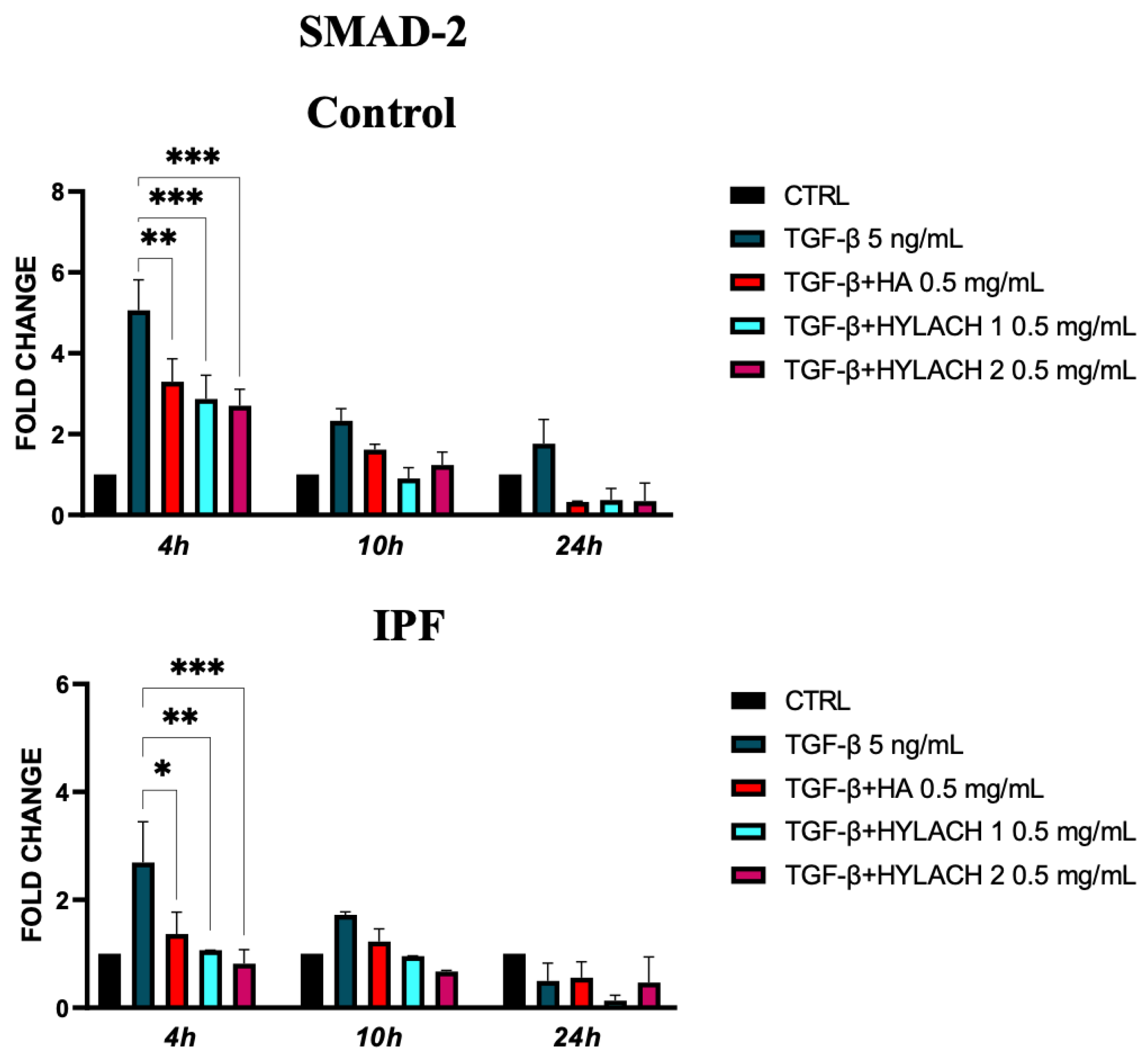
| Gene (Accession Number) | Name | Primer Sequences |
|---|---|---|
| IL-1β (NM_000576.3) | Interleukin 1 beta | Fw 5′-GAATCTCCGACCACCACTACAG-3′ Rv 5′-TGATCGTACAGGTGCATCGTG-3′ |
| LSGALS3 (NM_002306.4) | Galectin 3 | Fw 5′-CTGCTGGGGCACTGATTGT-3′ Rv 5′-TGTTTGCATTGGGCTTCACC-3′ |
| TNF-α (NM_000594.3) | TNF- alpha | Fw 5′-AAGCCTGTAGCCCATGTTGT-3′ Rv 5′-GGACCTGGGAGTAGATGAGGT-3′ |
| PPIA (NM_021130.5) | Peptidylprolyl Isomerase A | Fw 5′-GGGCTTTAGGCTGTAGGTCAA-3′ Rv 5′-AACCAAAGCTAGGGAGAGGC-3′ |
| COL-I (NM_000088.4) | Collagen I | Fw 5′-TGGAGCAAGAGGCGAGA-3′ Rv 5′-ACCAGCATCACCCTTAGCAC-3′ |
| COL-III (NM_000090.4) | Collagen III | Fw 5′-CGGGTGAGAAAGGTGAAGGAG-3′ Rv 5′-AGGAGGACCAGGAAGACCA-3′ |
| ELN (NM_000501.4) | Elastin | Fw 5′-CAGCTAAATACGGTGCTGCTG-3′ Rv 5′-AATCCGAAGCCAGGTCTTG-3′ |
| FN (NM_001306129.2) | Fibronectin | Fw 5′-TCAGCTTCCTGGCACTRCTG-3′ Rv 5′-TCTTGTCCTACATTCGGCGG-3′ |
| TGF-β (NM_000660.7) | Transforming Growth Factor-β | Fw 5′-CGACTCGCCAGAGTGGTTAT-3′ Rv 5′-AGTGAACCCGTTGATGTCCA-3′ |
| α-SMA (NM_001141945.3) | Alpha Smooth Muscle Actin | Fw 5′-ACTGAGCGTGGCTATTCCTCCGTT-3′ Rv 5′-GCAGTGGCCATCTCATTTTCA-3′ |
| SMAD-2 (NM_001003652.4) | Mothers against decapentaplegic homolog 2 | Fw 5′-TTTGCTGCTCTTCTGGCTCA-3′ Rv 5′-CCTTCGGTATTCTGCTCCCC-3′ |
| Compounds | Hylach® 1 | Hylach® 2 | HA | |||||||
|---|---|---|---|---|---|---|---|---|---|---|
| Time | 4h | 10h | 24h | 4h | 10h | 24h | 4h | 10h | 24h | |
| Normal subjects | ||||||||||
| Gene expression | COL-I | ↓↓↓↓ | - | - | ↓↓↓↓ | - | - | ↓↓↓ | - | - |
| COL-III | ↓↓↓↓ | - | - | ↓↓↓↓ | - | - | - | - | - | |
| Elastin | ↓↓↓↓ | ↓↓ | - | ↓↓↓ | ↓↓ | - | ↓↓ | - | - | |
| Fibronectin | ↓↓↓↓ | ↓↓↓ | - | ↓↓↓↓ | ↓↓↓ | - | ↓↓ | - | - | |
| TGF-β | ↓↓↓ | ↓↓ | - | ↓↓↓↓ | ↓↓ | - | ↓ | - | - | |
| α-SMA | ↓↓↓↓ | - | - | ↓↓↓↓ | - | - | ↓↓↓ | - | - | |
| SMAD-2 | ↓↓↓ | - | - | ↓↓↓ | - | - | ↓↓ | - | - | |
| IPF patients | ||||||||||
| COL-I | ↓↓ | - | - | ↓↓↓ | - | - | ↓ | - | - | |
| COL-III | ↓↓↓↓ | ↓↓ | - | ↓↓↓↓ | ↓ | - | ↓↓ | ↓ | - | |
| Elastin | - | - | - | - | - | - | - | - | - | |
| Fibronectin | ↓↓↓↓ | - | - | ↓↓↓↓ | - | - | - | - | - | |
| TGF-β | ↓↓↓ | ↓ | - | ↓↓↓↓ | ↓ | - | ↓↓ | - | - | |
| α-SMA | ↓↓↓ | - | - | ↓↓↓ | - | - | ↓ | - | - | |
| SMAD-2 | ↓↓ | - | - | ↓↓↓ | - | - | ↓ | - | - | |
| Compounds | Hylach® 1 | Hylach® 2 | HA | |||||||
| Time | 4h | 10h | 24h | 4h | 10h | 24h | 4h | 10h | 24h | |
| Normal subjects | ||||||||||
| Protein expression | COL-I | ↓↓↓↓ | ↓↓ | - | ↓↓↓↓ | ↓↓ | - | ↓ | ↓ | - |
| COL-III | ↓↓↓↓ | ↓↓↓ | ↓↓ | ↓↓↓↓ | ↓↓↓ | ↓↓↓ | ↓↓ | ↓ | - | |
| Elastin | ↓↓ | - | - | ↓↓↓ | - | - | - | - | - | |
| Fibronectin | ↓↓↓↓ | ↓↓ | - | ↓↓↓↓ | ↓↓ | - | ↓↓ | ↓ | - | |
| TGF-β | ↓↓↓ | ↓↓ | - | ↓↓↓ | ↓↓ | - | ↓↓↓ | ↓ | - | |
| IPF patients | ||||||||||
| COL-I | ↓ | - | - | ↓↓ | - | - | - | - | - | |
| COL-III | ↓↓↓ | ↓↓↓ | ↓↓↓ | ↓↓↓↓ | ↓↓↓ | ↓↓ | ↓ | ↓ | ↓ | |
| Elastin | ↓↓↓↓ | ↓↓↓↓ | ↓↓ | ↓↓↓↓ | ↓↓↓↓ | - | ↓↓ | ↓↓ | - | |
| Fibronectin | ↓ | ↓↓ | ↓ | ↓↓ | ↓↓ | ↓ | - | - | - | |
| TGF-β | ↓↓↓↓ | ↓↓ | ↓ | ↓↓↓↓ | ↓↓ | ↓ | ↓↓↓ | - | ↓ | |
Disclaimer/Publisher’s Note: The statements, opinions and data contained in all publications are solely those of the individual author(s) and contributor(s) and not of MDPI and/or the editor(s). MDPI and/or the editor(s) disclaim responsibility for any injury to people or property resulting from any ideas, methods, instructions or products referred to in the content. |
© 2023 by the authors. Licensee MDPI, Basel, Switzerland. This article is an open access article distributed under the terms and conditions of the Creative Commons Attribution (CC BY) license (https://creativecommons.org/licenses/by/4.0/).
Share and Cite
Donato, A.; Di Stefano, A.; Freato, N.; Bertocchi, L.; Brun, P. Inhibition of Pro-Fibrotic Molecules Expression in Idiopathic Pulmonary Fibrosis—Derived Lung Fibroblasts by Lactose-Modified Hyaluronic Acid Compounds. Polymers 2024, 16, 138. https://doi.org/10.3390/polym16010138
Donato A, Di Stefano A, Freato N, Bertocchi L, Brun P. Inhibition of Pro-Fibrotic Molecules Expression in Idiopathic Pulmonary Fibrosis—Derived Lung Fibroblasts by Lactose-Modified Hyaluronic Acid Compounds. Polymers. 2024; 16(1):138. https://doi.org/10.3390/polym16010138
Chicago/Turabian StyleDonato, Alice, Antonino Di Stefano, Nadia Freato, Laura Bertocchi, and Paola Brun. 2024. "Inhibition of Pro-Fibrotic Molecules Expression in Idiopathic Pulmonary Fibrosis—Derived Lung Fibroblasts by Lactose-Modified Hyaluronic Acid Compounds" Polymers 16, no. 1: 138. https://doi.org/10.3390/polym16010138
APA StyleDonato, A., Di Stefano, A., Freato, N., Bertocchi, L., & Brun, P. (2024). Inhibition of Pro-Fibrotic Molecules Expression in Idiopathic Pulmonary Fibrosis—Derived Lung Fibroblasts by Lactose-Modified Hyaluronic Acid Compounds. Polymers, 16(1), 138. https://doi.org/10.3390/polym16010138






